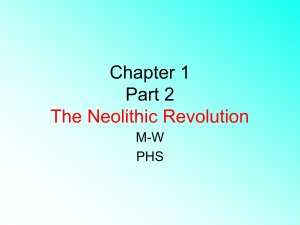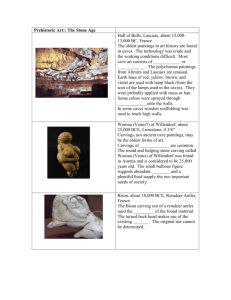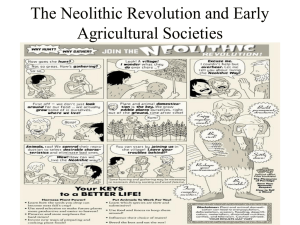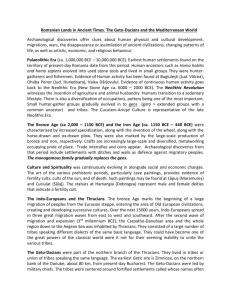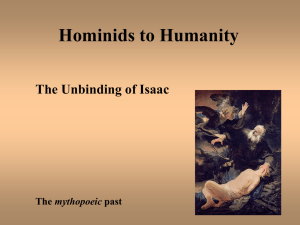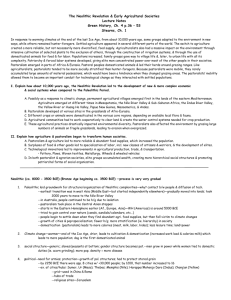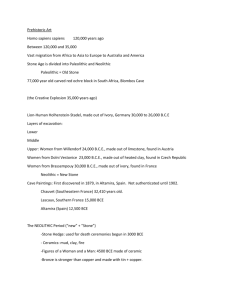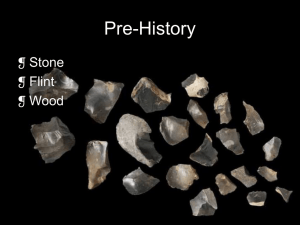1. Prehistory to Civilization
advertisement
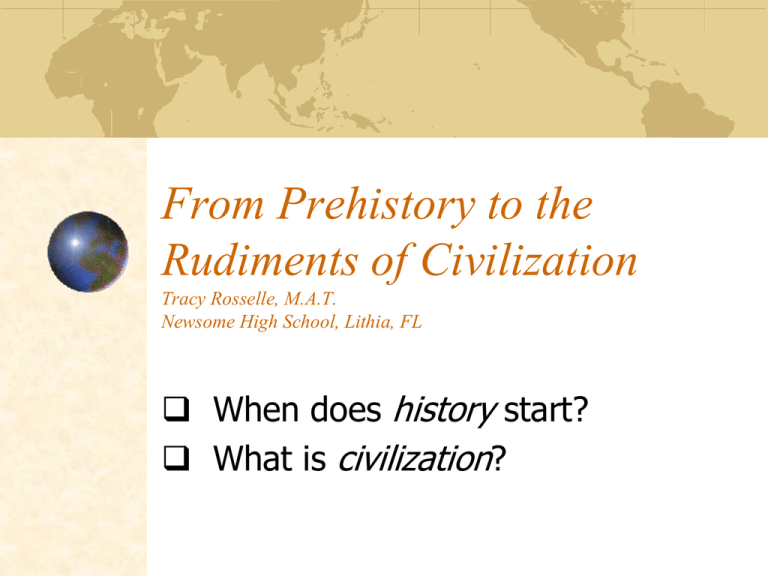
From Prehistory to the Rudiments of Civilization Tracy Rosselle, M.A.T. Newsome High School, Lithia, FL When does history start? What is civilization? Before history Scholars believe the world is more than 4.5 billion years old – and the earliest life forms began 4 billion years ago. Pangaea – the world’s lone landmass – broke into two supercontinents (Laurasia and Gondwana) about 180 million years ago … and subsequently these continents broke apart further into the continents we know today. Impact on life 65 million years ago: an asteroid 10 miles wide and traveling at 50,000 miles an hour hit near the present-day Yucatan peninsula. It opened a hole 3 miles deep in the Earth’s crust and blasted thousands of times its original mass into the atmosphere and even outer space. Dino didn’t die because he smoked too many cigarettes. Evidence of the impact is thought to be the “smoking gun” explanation for why dinosaurs died out long before humans arrived. Humans arrive Earliest humanlike creatures (hominids) emerged from eastern Africa 3-4 million years ago. Homo sapiens (“wise human”) appeared 100200 thousand years ago. Best-known variants: Neanderthal, Cro-Magnon. Modern humans – Homo sapiens sapiens – may have lived as early as 160,000 years ago. Migrations led to peopling of the planet by 10,000 BCE Stone Age Earliest tools made of wood, bone, animal skins and – most important, because they survive as artifacts – stone. Paleolithic (Old Stone Age) = 2.5 M to 10 K years ago: roughly coincides with the Pleistocene epoch, or last Ice Age. Neolithic (New Stone Age) = 8000 BCE Neolithic Revolution: transition from hunter-gatherer to farmer. Call it the Neolithic transition It took a few thousand years to transition – independently, in various parts of the world – to an agriculturally based society and economy. In regions that didn’t favor the cultivation of crops, an alternative lifestyle: pastoral nomadism, in which people lived off their herds of animals as they traveled to find grassland (or steppe land). Seeds in the ground and breeds on the ground Cereal farming came to dominate certain regions, while root farming took hold in other regions more suitable to those crops. Pastoralism and hunting or foraging remained more important for supplying food in lands less suitable for crop cultivation. Large domesticable animals more prevalent in Eurasia (key to Diamond’s thesis). First domesticated animal: the dog. Life in Neolithic communities As people started to farm, they settled down into communities, from which cities would later emerge. A more stable food supply (surplus) led to job specialization – but not necessarily a better life, at least initially. Early farmers were shorter than earlier foragers (less variety in diet/nutrition). Death from contagious disease more of a threat (settlements contaminated with human waste, vermin and the diseases of domesticated animals). More stability = more people Time 10,000 BCE 5000 BCE 3000 BCE 2000 BCE 1000 BCE 500 BCE World Population 4 million 5 million 14 million 27 million 50 million 100 million Surplus of food leads to innovation Job specialization – Not everyone needed to farm now, so some began tinkering with new technologies, leading eventually to jobs like blacksmith, miller, brewer, trader and priest. Three main craft industries common to almost all agricultural societies: pottery, metallurgy and textiles. From practical to artistic Pottery was the earliest craft industry. Clay pots were needed to store surplus food. Later, craftsmen began etching designs into their clay pottery then became a medium for artistic expression. The merits of metallurgy Copper was the earliest metal mined and later smelted for use in such things as tools and jewelry. Technology of smelting and casting copper: the foundation for later advances in working with gold and other metals. Metals were valuable because they could be made into more effective tools: knives, axes, plows, hoes, and weapons and armor. Softer “precious” metals, like gold and silver, were more rare and thus became valuable as status symbols. The Bronze Age Metalworkers in the Middle East around 4000 BCE created a stronger metal by alloying copper and tin bronze. Around 1200 BCE, tools and weapons made of iron – stronger and more useful than bronze – were developed, bringing the Bronze Age to a close. The wheel and writing Technological turning points included the wheel (c. 3500 BCE), which allowed for the transport of heavier loads and longer-distance travel and trade, and writing (c. 3500-3000 BCE), which enabled societies to keep records, pass on learning and transfer information more effectively. Writing = history This point in history – beginning about 5,000 years ago – is the point at which “history” really begins. Everything before the advent of writing is known as “prehistory.” Almost all cultures that reached a “civilized” state developed a system of script writing. One key exception: the Incas, a South American people who came along much later (mid13th century CE) and developed a unique system of recordkeeping called the quipu (KEE-poo). The quipu consisted of small cords of various colors and lengths, each suspended from a larger cord. Neolithic Age affects society Social classes and wealth disparity develop with the concept of private property. The most successful (strongest, ablest, most intelligent) and his/her family become the wealthy, ruling elite … while everyone else (95 percent of the population) remains in peasant/laborer/slave class. Gender roles change: men worked in fields, women inside the home over time, work outside the home seen as higher status. Culture Culture is NOT the same as civilization. Bands of humans developed shared ways of doing things – communicating, dressing the same, favoring certain foods, making tools – long before the Neolithic Revolution. Common components of culture today include clothing, work, sports, religion, values, family, government, economics, the arts, etc. Civilization (Latin for “citizen”) To say one society is more advanced or more “civilized” is to impart a value judgment that may not be supportable. Civilization took shape following the Neolithic Revolution. Its traditionally understood features: Advanced technology Advanced cities Complex institutions Specialized workers Recordkeeping Down by the river The first farming communities that developed into full-blown civilizations were along major river banks. The rivers provided a means of transportation and communication, and periodic flooding carried silt onto the land, making it more fertile. Irrigation required cooperation To control the flooding, large irrigation projects were undertaken – which required cooperation thus, institutions and social processes arose to meet the challenge: cities, government, law, military, social stratification. Cities became region’s economic center, or marketplace, and the river facilitated trade. First river-valley civilizations Mesopotamia (“land between the [Tigris & Euphrates] rivers”) Egypt Indus Fertile Crescent Sources The Earth and Its Peoples: A Global History (Bulliet et al.) Traditions & Encounters: A Global Perspective on the Past (Bentley & Ziegler) World History (Duiker & Spielvogel) Patterns of Interaction (McDougal Littell, publisher) The Eternal Frontier (Tim Flannery) AP World History review guides: The Princeton Review, Kaplan and Barron’s

